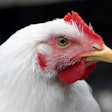
Scientific facts about animal welfare won’t influence consumers who either don’t understand the issue or are being swayed by powerful emotional narratives, concluded a panel of broiler welfare experts at the 2017 Chicken Marketing Summit. They said producers must step up their efforts to communicate with all food stakeholders about the welfare of broilers.
1. Design broiler welfare messaging that resonates with consumers.
Paradoxically, the broiler industry’s ability to grow birds quickly to market weight has become a negative consumer issue that must be addressed by chicken producers.
Sara Lilygren, formerly vice president of corporate affairs, Tyson Foods, said, “People don’t like the idea that somebody is pushing a creature beyond its natural limits.”
Producers need to explain that improved genetics, nutrition and management are responsible for the superior growth of broilers, said Anne-Marie Neeteson, vice president of welfare and compliance, Aviagen.
Another concern being fanned by activists is negativity about "big agriculture." Jack Hubbard, vice president of marketing, American Humane Association, said, “The totality of the industry is what activists focus on. At the heart of their argument is that big is bad.”
All the while, consumers are uncomfortable with polarized positions when it comes to their food decisions, said Jerome Lyman, former vice president of global quality systems, McDonald’s. He said producers must be careful to avoid what the activists are seeking – the polarization of views.
2. Know the audience for your animal welfare messaging.
Producers’ broiler welfare messaging should focus on consumers with open minds and who need a story or narrative in which to believe. “Trying to change the views of those who are committed on the issues is probably not worth the effort,” Lyman said. “Their views won’t be changed.”
Lilygren said consumers are often not even the real targets in activist campaigns. “The targets are the major brands and the governmental regulators who want to avoid being shamed, blackmailed or embarrassed about their animal welfare policies.
“In the animal welfare space, the audience that can make a difference is much smaller, much more high-powered and can motivate action on positions and policies. So, I would suggest that broiler producers need to get closer to our customers and longer in front of the issues that trouble us and come up with innovative solutions,” she said.
3. Communicate early on broiler welfare issues.
Don’t wait for consumer views about broiler welfare to take shape or the opportunity to have an impact will be lost, Lyman said.
“If you wait for a point of view about broiler welfare, particularly if is extreme, to take shape with consumers, you have probably lost your ability to intellectually impact the issue because by the time it comes to your table it is already full of emotion,” he said.
Chicken Marketing Summit 2018
Chicken Marketing Summit uniquely explores issues and trends in food marketing and consumer chicken consumption patterns and purchasing behavior. In addition to educational sessions, attendees have numerous networking opportunities to foster interaction between speakers and fellow poultry industry peers. Chicken Marketing Summit 2018 will take place at the Four Seasons Resort Orlando at Disney World in Orlando, Florida on July 22 -24, 2018.
















